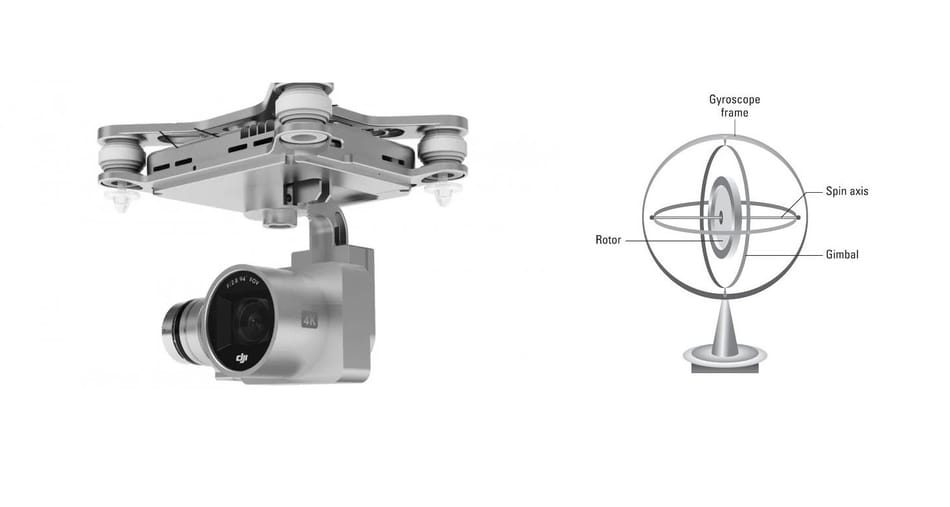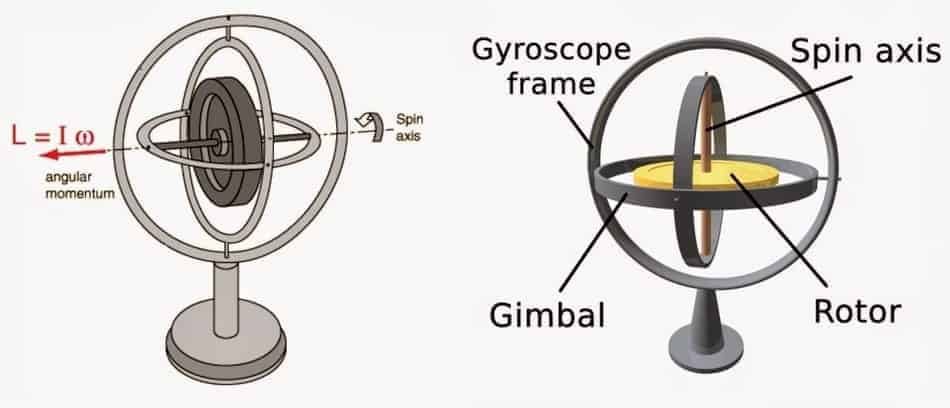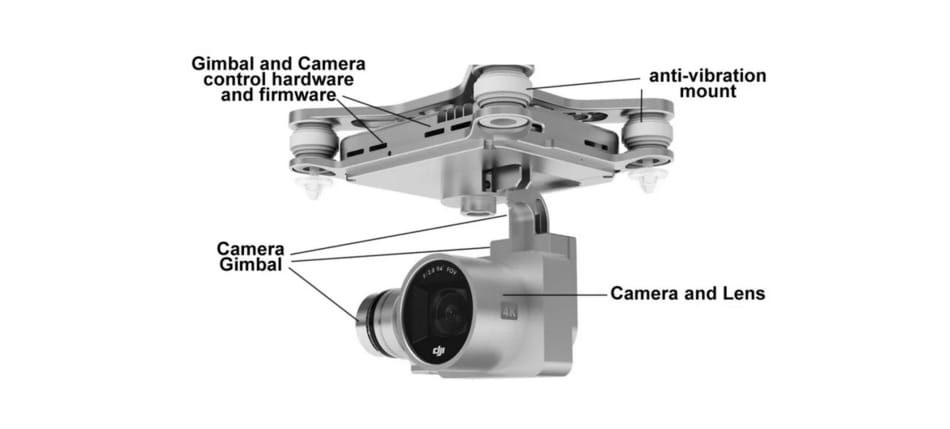Drone Gimbals Explained: How They Work

The popularity of drones is becoming more pronounced, as well as their technological development. Drone gimbals are the single most important piece of tech in a drone. They’re responsible for stabilizing and capturing video footage from high altitudes, making them an integral part of any professional or hobbyist’s kit.
If you’re looking to get into drones, it’s worth investing in one that comes with a high-quality gimbal. You’ll be able to capture smooth footage without worrying about your camera shaking around too much – which can happen if you don’t have a good stabilization system on board! Therefore, in this article, we will teach you everything you need to know about this piece of technology and how it works!
What is a Drone Gimbal?
A drone gimbal is a support system that carries a camera and allows it to remain at the same angle, regardless of motion, while it maintains the direction of shooting. More advanced gimbals come with an anti-vibration feature that reduces camera shake, so you get more stable videos.
Gimbals are fascinating pieces of technology. They can allow a camera to stay steady and unaffected while the drone is flying in the air. Also, with this technology the videographers to capture perfectly smooth footage with minimal effort. By using a drone gimbal you will reduce vibrations on the camera despite its movement by the help of calibrated electronic motors and intelligent sensors which automatically compensate for any movement detected across all three axes.
Check out the best Drone Gimals Here.
How do Drone Gimbals Work?
The design of a drone gimbal is very simple. You have the mechanical parts of the gimbal that comes with the camera mount and three separate motors that work in tandem to keep the camera stable and without vibration.

The computing power behind how a gimbal works is however little more complicated.
The controller in the gimbal collects all the information from the mechanical forces that are created by the drone during the flight which is then converted into an electronic signal. The electromechanical device that is capable of converting these g-forces is Micro-Electro-Mechanical Systems (MEMS).
MEMS sensors are built with microscopic motors that respond to the surrounding environment. These tiny structures move in response to g-forces, such as from gusts of wind or your drone swaying back and forth. As they shift position, these MEMS devices send electrical signals which give precise information about the direction and force every second!
The way drone gimbals can also work is by using an Inertial Measurement Unit (IMU) to measure orientation and acceleration, which are fed into a controller board to stabilize each axis separately with different motors!
The Difference Between 2-axis And 3-axis Drone Gimbal?

The main difference between 2-axis and 3-axis drone gimbals is stabilization. The 2-axis gimbal stabilization on 2 axes: pitch and roll. The 3-axis gimbal offers stabilization on 3 axes: pitch, roll and yaw. With this extra level of stabilization, 3-axis gimbals are great for shooting videos. Yaw stabilization reduces horizontal movement for professional results.
That said, not all 3-axis gimbals are necessarily superior to 2-axis gimbals. 2-axis gimbals are as good as 3-axis gimbals for taking photos. In addition, 2-axis gimbals are lighter, consume less battery power, and are less expensive than 3-axis models.
How to Choose the Right Gimbal For Your Drone?
You will find that there are many different gimbal options. The main difference between the camera gimbal is the way it is attached to the drone. So if you have a drone you must choose what type of gimbal do you want. Which gimbal to buy – 2-axis (2D) or 3-axis (3D)? Each has its own purpose. Let’s find out which gimbal best suits your drone.
3-axis Mount Gimbal
3D gimbals perfectly stabilize and level the picture, even if the drone falls into a deep air hole or “rattles” from gusts of wind. This option is indispensable for professional aerial photography. Hollywood uses a 3-axis gimbal for their movies.
Advantages of 3D gimbals:
- Align any video qualitatively.
- A spare battery can solve the flight time problem.
Disadvantages of 3D gimbals:
- High price – quality is expensive.
- Relatively heavy weight, which reduces flight time.
2-axis Mount Gimbal
If you are looking to stabilize your footage for extreme FPV flights, or are planning to shoot “for fun,” then look at 2-axis gimbals. These devices are inexpensive and lightweight, which will not reduce flight time or burden your wallet.
Advantages of 2D gimbals:
- Low cost, which is often the main argument for an amateur.
- Relatively low weight, which does not affect the flight characteristics of the drone.
Disadvantages of 2D gimbals:
- Sometimes they create horizontal vibrations and are not suitable for flying in windy conditions.
You can’t go wrong with the Zenmuse line of gimbals from DJI that provide superb technology and are easy to use. Before you open up your package, start by looking at the instruction manual or user guide. You can find installation instructions on YouTube as well!
Regular Gimbal Maintenance
If you’ve ever had an overload warning, noticed tilted horizons, or abnormal vibrations then it’s likely that your gimbal is obstructed with grass. Then it is important to do a calibration. Click here to learn more about Drone Calibration.
An overflow alert usually appears when the drone has been dropped and there is grass in front of the camera lens. Simply remove grass that is blocking the gimbal or place it on a spot where no grass will get in the way to calibrate your drone and get it back to shape!
You can fix a tilted horizon by performing gimbal calibration on the ground through your desired app easily. Another way is to adjust it in flight, but that’s not really recommended unless you experience abnormal vibrations.
If you want to know more about How do Drones Work and What is Drone Technology, read this article.
Where to Buy a Gimbal For Your Drone?
When you buy a camera gimbal from the manufacturer of your drone, they will provide documentation on how to use and maintain it. This is not only beneficial for support but takes out some guesswork with compatibility, which can be tough when every single model operates differently.
That being said, gimbals are designed specifically for one’s specific model so there shouldn’t be any major issues! Here we will present you the websites where you can find more about gimbals for your drone:
- Amazon: Amazon offers a wide variety of camera gimbals that are available from different sellers. Most products have customer reviews, which can help you to choose the best one for your drone model. Certainly, one of the first choices when choosing a gimbal.
- HeliPal: This shop offers everything that is drone-related. If you are searching for camera gimbals for your drone, you will a wide variety of gimbals here.
- Photography Store: Most photography stores, such as Adorama or B&H are a great choice for you to find a perfect gimbal for your drone. You have the option on the website to search for “camera gimbals” and see what it has to offer.
Buy a Gimbal Without a Camera or With a Camera?
If you already have a compatible camera then the gimbal alone is a good choice allowing you to use your own camera. If you don’t have a camera, a separately sold gimbal will let you choose a compatible camera for your photos and videos.
A gimbal with a built-in camera is very convenient since it allows you to take videos without waiting. Integrated camera drone gimbals also allow you to control camera settings and gimbal position using a joystick or mobile app. A camera sold separately may not offer this option.
Conclusion
If you have read the whole article, by now you know how a gimbal works. The market for camera gimbals is not very large. The best option is to buy a gimbal for the drone from the company that made the drone itself. If you plan to shoot a high-quality picture, then camera stabilization must be present. I hope you now fully understand how drone gimbal works and how to choose the right one for your drone.

